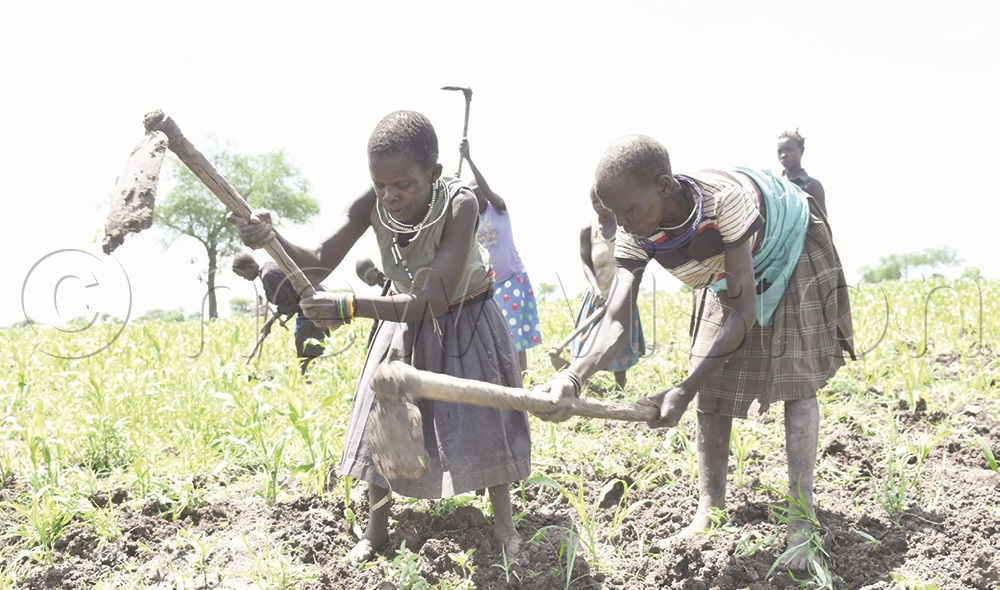Uganda’s agricultural heartland is a paradox: despite being the backbone of the country’s economy and sustaining over 65% of the population, many farming regions remain mired in poverty, according to the 2023/24 National Household Survey.
In the second part of a four-part series, Joshua Kato explores the critical role of seeds in determining crop yields and examines the underlying factors that perpetuate poverty in Uganda’s farming communities.
Six women rhythmically raise their hoes and hit the soil almost at the same time. The ground is soft, owing to the previous night’s downpour.
While they remove the weeds between the rows of maize and sorghum, the women chat about the impending harvest.
“I harvested more than usual because I sowed improved seeds,” Mary Angom says.
Last season, her harvest of maize was about 500kg compared to 100kg that she harvested from the same space previously.
Her enterprise, about three acres, is located in Lomuriang-Alepan village, on the outskirts of a modern cereals farm owned by Pr Robert Kayanja in Napak district, Karamoja sub-region.
Angom and other farmers planted improved seeds, following the encouragement of officials at Pr Kayanja’s farm.
“We saw the crops at the ‘big farm’ were very good and found out that they were planting different seeds. We are now planting them too,” Angom says.
Farmers in Karamoja and Teso sub-regions mainly grow sorghum and maize as well as millet, groundnuts, green gram beans and vegetables. However, in Karamoja, as well as Katakwi and Amuria districts in Teso, many smallholder farmers generally gather low yields owing to the low uptake of improved seeds.
Other parts of Teso, including Soroti, Serere, Bukedea, Ngora and Kumi districts, are performing better because they have adopted the use of improved seeds.
The good performance is reflected in terms of harvests per season, general nutrition and household income.
Christine Lolupe cultivates one acre of land in Longerechera, Napak. Unlike Angom, her yields are dismal as she uses ordinary seed.
She selects what she assumes is good seed from the previous harvest and stores it above the fireplace in her kitchen, an age-old practice.
The use of ordinary seeds in these areas, where nearly 98% of the population are farmers, are not only perennially food insecure, but also generally poor.
According to the 2023/24 National Household Survey carried out by the Uganda National Bureau of Statistics (UBOS), with a total population of two million people, Karamoja reported poverty levels of around 74% among households.
Northern Uganda had 42%, while eastern Uganda reported 35%.
In comparison, in the central region, which has the highest adoption of improved agriculture technologies, poverty stood at 9.8%.

The western region, which has the second-highest adoption of improved technologies, reported 14%.
Improved seed, better yield
Turning the tide in Karamoja and Teso sub-regions requires a high adoption of improved seeds.
This applies to cereals, including maize, sorghum, millet, rice; tubers such as cassava and potatoes; legumes and bananas.
CGIAR is a formula used to gauge growth of certain aspects, seed usage in this case.
According to a report by Seed Equal — an organisation advocating improved seeds for all farmers — using the CGIAR formula, the Ugandan seeds market is projected to grow to $8.60b.
It is estimated to grow to $10.67b in 2030. The report rates this growth as ‘low’compared to other African countries such as Kenya.
“The industry operates through two supply systems; the informal and formal. The formal system, which is fully regulated, serves 20-30% of the market. The informal system takes 70%-80% of the market,” the report says.
The informal system revolves around farmers saving seed from the previous harvest or begging for seed from neighbours.
The formal Ugandan seed market is moderately saturated, with a few major players taking the lion’s share.
These players include Syngenta, Equator Seeds, Victoria Seeds, Bejo, Sakata, Kenya Highland Seed, Rijk Zwaan, Seed Co, East-West Seed, East African Seed, Limagrain, FICA Seeds and NASECO.
With about 21 registered seed companies located mainly in the central and eastern parts of the country, reports indicate that at 30%, Ugandan farmers have a much lower adoption rate of new technologies compared to farmers in the developed world.
And even when one buys improved seed, for example, they do not want to apply fertilisers or use the right plant spacing or post-harvest handling.
Regional uptake According to the Ministry of Agriculture, Animal Industry and Fisheries, there is higher adoption of improved seeds in the Elgon/Bukedi area, mainly for Irish potatoes and cereals; the central region, especially areas of Greater Mubende, Kiboga and Luwero districts for maize; and the northern region, especially Nwoya and Amuru districts among large-scale cereal farmers. Comparatively, even production per acre in high-adoption areas is rising. Dr Godfrey Asea, a seeds breeder from the National Agricultural Research Organisation (NARO), says the entity releases new improved seeds for cereals, tubers and bananas every year.
The purpose is to improve yields of the key crops in Uganda.
“If you buy 1kg of improved seed, for example of maize at sh10,000, it can give you at least 100kg of grain. Even if you sell a kilogramme at sh600, this gives you sh60,000. It makes economic sense,” he says.
Joseph Kato, a maize farmer and processor in Buwama, Mpigi district, attests to the benefits of using improved seed as well as fertilisers.
“I use hybrid seeds and NPK fertilisers and my yields per acre average 2.5 tonnes,” he says.
Kato grows maize on over 60 acres per season, which he processes into flour and livestock feed. Before he started using improved seed, his harvests averaged one tonne per acre.
Abel Mwaka, a large-scale maize and rice farmer in Kisita village, Kakumiro district in Bunyoro, also uses improved seeds and manure from his livestock.
“Previously, I used to simply plant the improved seeds, but the yields were low. I started using at least a tonne of manure per acre from the chicken house, and the results are good,” he says.
Mwaka used to harvest around 600kg per acre of maize. Partial adoption A study was conducted by NARO and UBOS and a report titled Agricultural Diversity Under Stress, was released in March.
It focused on the adaptation of new agricultural innovations, including seeds. It indicated a remarkable rise in the use of improved seeds in Uganda.
“Fields are mixed with farmers recycling from previous harvests (including hybrids) and drawing seeds from informal sources. This means that the intended traits from breeding are not realised,” the report indicates.
In areas like Karamoja and parts of Teso, some farmers use seeds saved from previous harvests.
The yield from saved seeds is ordinary, and the farmers who use them claim that they cannot afford to buy improved seeds.
On average, a kilogramme of open-pollinated varieties for maize costs sh5,000, while hybrids cost sh10,000. An acre needs 10-12kg of maize.
“That is costly,” Christine Lolupe exclaims. Patrick Lokeris, an agri-inputs dealer in Napak town council, says seed sales are low.
“We sell more ordinary seeds than improved ones,” he says.
But even those who access the improved seeds do not adopt the entire value chain, especially using fertilisers and proper harvesting practices.
Yet, improved seeds do not work in isolation from other supportive factors.
“Improved seeds perform better with fertilisers. However, when a farmer buys them, he plants them without fertilisers in many cases. This affects performance,” Josephine Okot, the proprietor of Victoria Seeds, says.
According to the agriculture ministry, usage of fertilisers in Uganda stands at less than 5%. In most cases, fertiliser is only applied on large commercial farms.
Godfrey Katwere, the NASECO marketing manager, says this is why hybrid maize seeds produce about two tonnes on most Ugandan farms, even when they can give as much as five tonnes an acre.
So, it should not be just about the seed.
“Farmers need access to affordable fertilisers, pest control and financial services to support complementary investments,” states a March 2025 report; Socio–technical innovation bundles for agri-food systems transformation.
Karamoja interventions
In Karamoja, a combination of factors slows down the uptake of improved seeds.
Jackson Angella, an agriculturalist in Napak district, blames limited access to agricultural inputs on high illiteracy rates, poverty and unpredictable weather.
He advocates affirmative action through free distribution of seeds and targeted research to produce seeds specifically suited for the sub-region’s weather.
“Karamoja requires crops that mature faster than ordinary seeds due to the unpredictable rainfall pattern,” Angella says.
He adds that the Nabuin Farm Institute should provide non-formal extension training for farmers to improve farming/agricultural skills.
Occasionally, the Government has distributed improved seeds to Karamoja. Whenever this is done, the harvests are good.
Meri Jino, the Kaabong LC5 chairperson, emphasises the urgency of seed distribution in tandem with the known weather patterns.
“This distribution should be done each year and before the planting season,” he says.
In the 2022 planting season, the Government, through the National Agricultural Advisory Services, sent seeds worth sh800m (about 90 tonnes) to Karamoja.
“That season, we had good yields compared to previous seasons. You could see food in the population,” Meri Jino says.
Florence Nambozo, the state minister for Karamoja affairs, expressed concern over the region’s severe food shortages.
She encouraged scientists to explore ways to improve agricultural production, including research on crops and artificial insemination.
“Let us do our best as researchers to ensure Karamoja can feed itself,” Nambozo said in May.
More exposure for farmers in Karamoja can also improve uptake of better practices.
“We should also get model farms with best practices set up for the population. I have seen farmers around Napak planting improved seeds. Some are even using tractors to plough mainly because they have seen the yields that Pr Kayanja is getting at his farm.”
In response to these challenges, the Government, through the Nabuin Zonal Agricultural Research Institute, is developing improved seed varieties suitable for Karamoja’s climate.
These include sorghum, millet and maize. There is also ongoing research in livestock pastures.
Next week, why in depending on rain, sowing poverty will continue.
Christine Lokonoi, a farmer in Amudat district, and her husband storing grains in her granary. Those who get improved seeds also need to adopt proper post-harvesting practices. (Photos by Joshua Kato)





